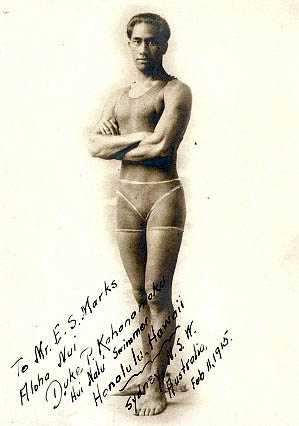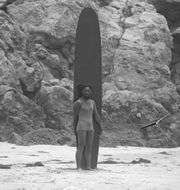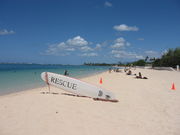Duke Kahanamoku
| Olympic medalist | ||
 Duke Kahanamoku |
||
| Medal record | ||
| Competitor for |
||
|---|---|---|
| Men's swimming | ||
| Gold | 1912 Stockholm | 100 m freestyle |
| Gold | 1920 Antwerp | 100 m freestyle |
| Gold | 1920 Antwerp | 4x200 m freestyle relay |
| Silver | 1912 Stockholm | 4x200 m freestyle relay |
| Silver | 1924 Paris | 100 m freestyle |
- The Big Kahuna redirects here. For the film, see The Big Kahuna (film).
Duke Paoa Kahinu Mokoe Hulikohola Kahanamoku (August 24, 1890-January 22, 1968) was a Hawaiian swimmer, actor, lawman, and businessman credited with spreading the sport of surfing.[1] He was a five-time Olympic medalist in swimming.
Contents |
Early years
The name "Duke" is not a title, but a given name. He was named after his father, Halapu Kahanamoku, who was christened "Duke" by Bernice Pauahi Bishop in honor of Prince Alfred, Duke of Edinburgh, who was visiting Hawaii at the time of the elder man's birth in 1869. The younger "Duke," as eldest son, inherited the name.
Growing up on the outskirts of Waikiki (near the present site of the Hilton Hawaiian Village), Kahanamoku spent his youth as a bronzed beach boy. It was at Waikiki Beach where he developed his surfing and swimming skills. In his youth, Kahanamoku preferred an old-school (traditional) surf board, which he called his "papa nui", constructed after the fashion of ancient Hawaiian "olo" boards. Made from the wood of a koa tree, it was sixteen feet (4.8 m) long and weighed 114 pounds (52 kg). The board was without a skeg, which had yet to be invented. In his later career, he would often use smaller boards, but always preferred those made of wood.
On August 11, 1911, in an amateur swim meet, Kahanamoku was timed at 55.4 seconds in the 100 yard (91 m) freestyle, beating the existing world record by 4.6 seconds, in the salt water of Honolulu Harbor. He also broke the record in the 220 yd (201 m) and equaled it in the 50 yd (46 m), but the Amateur Athletic Union (AAU), in disbelief, would not recognize these feats until many years later. The AAU initially claimed that the judges must have been using alarm clocks rather than stopwatches, and later claimed that ocean currents aided Kahanamoku.[2]
Career and legacy

Kahanamoku easily qualified for the U.S. Olympic swimming team in 1912, breaking the record for the 200 meter freestyle in his trial heat for the 4×200 relay. He went on to win a gold medal in the 100 meter freestyle in the 1912 Olympics in Stockholm, and a silver with the relay team. During the 1920 Olympics in Antwerp, he won gold medals both in the 100 meters (bettering fellow Hawaiian Pua Kealoha) and in the relay. He finished the 100 meters with a silver medal during the 1924 Olympics in Paris, with the gold going to Johnny Weissmuller and the bronze to Duke's brother, Samuel Kahanamoku. He also played for the U.S. water polo team at the 1932 Summer Olympics.
Between Olympic competitions, and after retiring from the Olympics, Kahanamoku traveled internationally to give swimming exhibitions. It was during this period that he popularized the sport of surfing, previously known only in Hawaii, by incorporating surfing exhibitions into these visits as well. His surfing exhibition at Sydney's Freshwater Beach on December 23, 1914 is widely regarded as a seminal event in the development of surfing in Australia.[3] The board that Kahanamoku built from a piece of pine from a local hardware store is retained by the Freshwater Surf Club. There is a statue of Kahanamoku on the headland at Freshwater. He also made surfing popular in mainland America first in Santa Cruz, California.
During his time living in Southern California, Kahanamoku performed in Hollywood as an extra and a character actor in several films. In this way, he made connections with people who could further publicize the sport of surfing. Kahanamoku was involved with the Los Angeles Athletic Club, acting as lifeguard and competing on both swimming and water polo teams.
While living in Newport Beach, California on June 14, 1925, Kahanamoku rescued eight men from a fishing vessel that capsized in heavy surf while attempting to enter the city's harbor. Twenty-nine fishermen went into the water and seventeen perished. Using his surfboard, he was able to make quick trips back and forth to shore to increase the number of sailors rescued.[4] Two other surfers saved four more fishermen. Newport's police chief at the time called Duke's efforts "the most superhuman surfboard rescue act the world has ever seen."

In 1940, he married Nadine Alexander, who accompanied him when he traveled. Kahanamoku was the first person to be inducted into both the Swimming Hall of Fame and the Surfing Hall of Fame. The Duke Kahanamoku Invitational Surfing Championships are named in his honor. He is a member of the U.S. Olympic Hall of Fame. He served as sheriff of Honolulu, Hawaii from 1932 to 1961, serving 13 consecutive terms. During this period, he also appeared in a number of television programs and films, such as Mister Roberts (1955).
Kahanamoku was a friend and surfing companion of heiress Doris Duke, who built a home (now a museum) on Oahu named Shangri-la.
Hawaii music promoter Kimo Wilder McVay capitalized on Kahanamoku's popularity by naming his Waikiki showroom "Duke Kahanamoku's", and giving Kahanamoku a piece of the financial action in exchange for the use of his name. It was a major Waikiki showroom in the 1960s and is remembered as the home of Don Ho & The Aliis from 1964 through 1969.
Kahanamoku's name is also used by Duke's Canoe Club & Barefoot Bar, a beachfront bar and restaurant in the Outrigger Waikiki On The Beach Hotel. There is a chain of restaurants named after him in California and Hawaii called Duke's. A monument at Waikiki beach in Honolulu honors his memory. It shows Kahanamoku standing in front of his surfboard with his arms outstretched. Many honor him by placing leis on his statue. There is a webcam watching the statue, allowing visitors from around the world to wave to their friends.
In 2002, Kahanamoku was featured on a first-class letter rate postage stamp of the United States Postal Service.[5]
Duncan v. Kahanamoku
Kahanamoku was the pro forma defendant in the landmark Supreme Court case Duncan v. Kahanamoku. While Kahanamoku was a military police officer during World War II, he arrested Duncan for public intoxication. At the time, Hawaii, not yet a state, was being administered under the Hawaiian Organic Act which effectively instituted martial law on the island. Duncan was therefore tried by a military tribunal and appealed to the Supreme Court. In a post hoc ruling, the court ruled that trial by military tribunal was, in this case, unconstitutional.[6]
Death
Kahanamoku died of a heart attack on January 22, 1968 at the age of 77. For his burial at sea a long motorcade of mourners, accompanied by a 30-man police escort, moved across town to Waikiki Beach. Reverend Abraham Akaka, the pastor of Kawaiahao Church, performed the service. A group of beach boys sang Hawaiian songs, including "Aloha Oe". His ashes were scattered into the ocean.
See also
- Duke Paoa Kahanamoku Lagoon
- Duke Kahanamoku Invitational Surfing Championship
References
- ↑ Hall, Sandra Kimberly. (2004). Duke: A Great Hawaiian. Honolulu, HI: Bess Press. ISBN 1573062308.
- ↑ "Duke Kahanamoku. Notable Asian Americans. Gale Research, 1995. Reproduced in Biography Resource Center. Farmington Hills, Mich.: Thomson Gale. 2007.
- ↑ Osmond, Gary. (2010). 'Honolulu Māori': Racial Dimensions of Duke Kahanamoku's Tour of Australia and New Zealand. New Zealand Journal of History, 44(1), 22–34.
- ↑ Gault-Williams, Malcolm. "Biography: Corona Del Mar Save". Legendary Surfers. Hawaiianswimboat.com. http://www.hawaiianswimboat.com/duke6.html. Retrieved 21 November 2008.
- ↑ USPS - July 30, 2002 - Father Of International Surfing To Be Honored On New Postage Stamp
- ↑ "Answers.com - Duncan v. Kahanamoku". http://www.answers.com/topic/duncan-v-kahanamoku.
Articles
External links
- Kahanamoku Sons bio of Duke
- Moments with Duke highlights, pictures, & videos
- Surfline bio of Duke
- Undated photo of Kahanamoku from the Library of Congress collection
- Video of the Duke Kahanamoku Statue at the Surfers Hall of Fame in Huntington Beach, California
- Info on Hawaii, its people and history.
- Duke Kahanamoku at the Internet Movie Database
- Duke's restaurant website
- More on Duke Kahanamoku and other surfing heroes
|
|||||
|
|||||